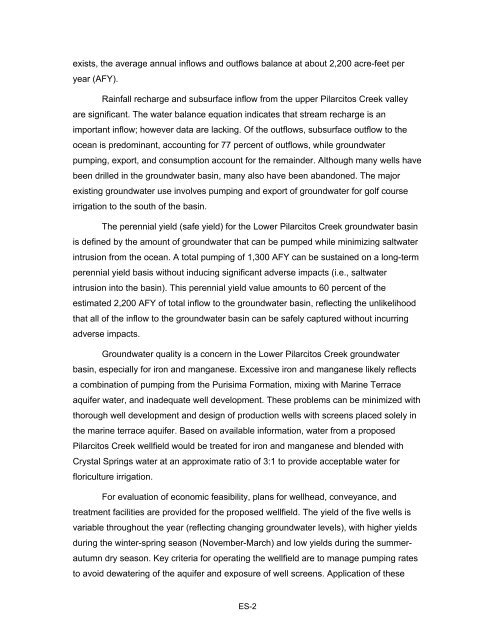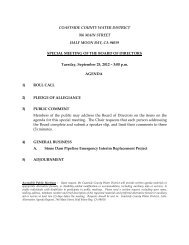Lower Pilarcitos Creek Groundwater Basin Study - Coastside ...
Lower Pilarcitos Creek Groundwater Basin Study - Coastside ...
Lower Pilarcitos Creek Groundwater Basin Study - Coastside ...
You also want an ePaper? Increase the reach of your titles
YUMPU automatically turns print PDFs into web optimized ePapers that Google loves.
exists, the average annual inflows and outflows balance at about 2,200 acre-feet per<br />
year (AFY).<br />
Rainfall recharge and subsurface inflow from the upper <strong>Pilarcitos</strong> <strong>Creek</strong> valley<br />
are significant. The water balance equation indicates that stream recharge is an<br />
important inflow; however data are lacking. Of the outflows, subsurface outflow to the<br />
ocean is predominant, accounting for 77 percent of outflows, while groundwater<br />
pumping, export, and consumption account for the remainder. Although many wells have<br />
been drilled in the groundwater basin, many also have been abandoned. The major<br />
existing groundwater use involves pumping and export of groundwater for golf course<br />
irrigation to the south of the basin.<br />
The perennial yield (safe yield) for the <strong>Lower</strong> <strong>Pilarcitos</strong> <strong>Creek</strong> groundwater basin<br />
is defined by the amount of groundwater that can be pumped while minimizing saltwater<br />
intrusion from the ocean. A total pumping of 1,300 AFY can be sustained on a long-term<br />
perennial yield basis without inducing significant adverse impacts (i.e., saltwater<br />
intrusion into the basin). This perennial yield value amounts to 60 percent of the<br />
estimated 2,200 AFY of total inflow to the groundwater basin, reflecting the unlikelihood<br />
that all of the inflow to the groundwater basin can be safely captured without incurring<br />
adverse impacts.<br />
<strong>Groundwater</strong> quality is a concern in the <strong>Lower</strong> <strong>Pilarcitos</strong> <strong>Creek</strong> groundwater<br />
basin, especially for iron and manganese. Excessive iron and manganese likely reflects<br />
a combination of pumping from the Purisima Formation, mixing with Marine Terrace<br />
aquifer water, and inadequate well development. These problems can be minimized with<br />
thorough well development and design of production wells with screens placed solely in<br />
the marine terrace aquifer. Based on available information, water from a proposed<br />
<strong>Pilarcitos</strong> <strong>Creek</strong> wellfield would be treated for iron and manganese and blended with<br />
Crystal Springs water at an approximate ratio of 3:1 to provide acceptable water for<br />
floriculture irrigation.<br />
For evaluation of economic feasibility, plans for wellhead, conveyance, and<br />
treatment facilities are provided for the proposed wellfield. The yield of the five wells is<br />
variable throughout the year (reflecting changing groundwater levels), with higher yields<br />
during the winter-spring season (November-March) and low yields during the summerautumn<br />
dry season. Key criteria for operating the wellfield are to manage pumping rates<br />
to avoid dewatering of the aquifer and exposure of well screens. Application of these<br />
ES-2



